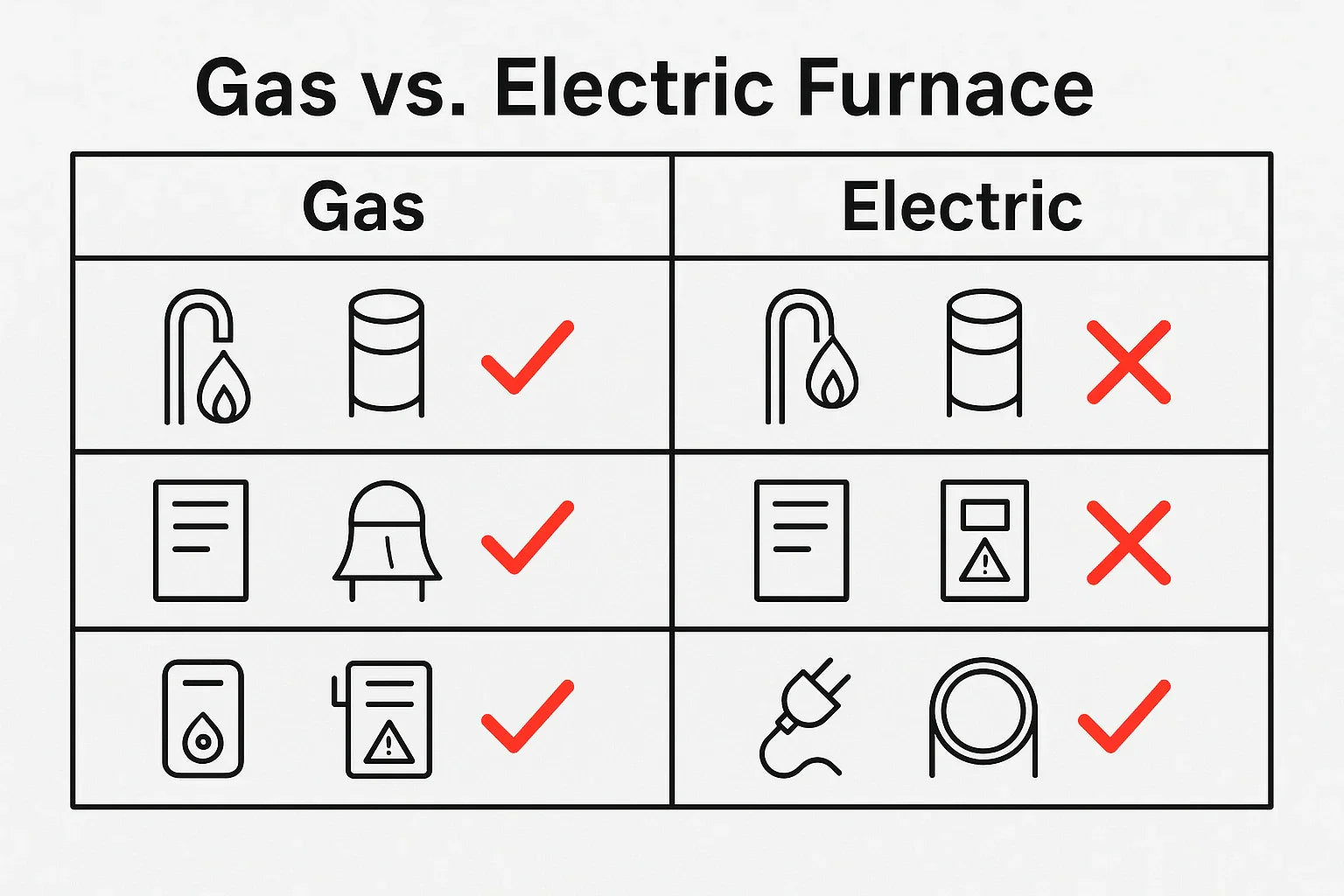When shopping for a new furnace, most homeowners compare costs and efficiency. But one of the biggest—and often overlooked—factors is installation complexity. Whether you’re leaning toward gas or electric, it’s important to understand what’s involved behind the scenes before you commit.
From gas line hookups to electrical panel upgrades, the installation process can significantly impact your upfront costs, timeline, and even safety. In this guide, we’ll break down the real-world differences between gas vs. electric furnace installation—so you know exactly what to expect.
Why Installation Matters When Choosing a Furnace
A furnace isn’t a plug-and-play appliance. Installation involves infrastructure, local code compliance, labor, and sometimes even home modifications. And while the furnace unit itself may cost between $1,500–$3,500, installation can double that number depending on what’s needed.
Poor installation doesn’t just risk performance issues—it can also:
-
Increase energy use
-
Shorten system lifespan
-
Create serious safety hazards, especially with gas systems
If you’re debating between furnace types, installation requirements could easily tip the scale one way or the other.
What’s Involved in Installing a Gas Furnace?
Gas furnaces are popular in colder climates for their high heat output and lower fuel costs. But they require more infrastructure and technical know-how to install safely.
Gas Line Hookup
The most obvious requirement: access to a gas source.
-
If your home already has a natural gas connection, installation is simpler.
-
If not, you’ll need to install a new gas line from the street or use a propane tank, which adds time, cost, and permitting.
-
All connections must meet local code and often require a licensed plumber or HVAC contractor.
The International Association of Certified Home Inspectors stresses the importance of gas line sizing, proper shutoff valves, and leak testing as part of safe installation.
Venting Requirements
Gas furnaces must safely expel combustion gases—like carbon monoxide—outside the home. This typically requires:
-
A flue pipe or direct vent system
-
Proper clearances from windows, walls, and attic spaces
-
Routing through the roof or exterior wall
Incorrect venting is a major red flag during home inspections. According to Energy.gov, combustion venting is one of the most critical parts of a gas system's safe operation.
Electrical and Thermostat Hookup
Even though it’s a “gas” furnace, it still needs:
-
A 120V power source for the blower motor and control board
-
A compatible thermostat, often low-voltage wired
While this part is fairly standard, your technician will confirm that your panel has space and capacity for the connection.
Installing an Electric Furnace: Simpler, But Power-Hungry
If you’re considering an electric furnace, the good news is: installation is often faster and less invasive. But there are still a few caveats—especially when it comes to electrical capacity.
Electrical Panel Capacity
Electric furnaces require a dedicated high-amperage circuit—usually 60 to 80 amps or more. That means your home’s main panel must be able to handle the load.
-
Older homes may need a panel upgrade or subpanel installation
-
High-capacity wire must be run from the panel to the furnace location
The Spruce offers a helpful guide for homeowners on understanding breaker limits and safe load sizing.
No Gas Line or Venting Needed
Here’s where electric systems shine:
-
No need for gas hookup
-
No risk of carbon monoxide
-
No combustion gases = no venting required
This not only reduces cost and time—it also gives you more flexibility on where the unit can be installed.
Faster Install Time
With the right panel setup in place, an electric furnace can usually be installed in a single day, with fewer disruptions to your home. And because there's no combustion involved, there's no need to worry about venting or potential emissions.
According to the U.S. Energy Information Administration (EIA), burning natural gas emits carbon dioxide, methane, and other greenhouse gases—both during use and throughout its supply chain. That makes electric systems, especially in clean-grid areas, a lower-emission option right from installation through operation.
Permits and Code Considerations
Both furnace types require compliance with local building codes. Depending on your location, this could include:
-
Mechanical permit
-
Electrical permit
-
Gas permit (for gas systems)
-
Post-installation safety inspection
Most regions require a licensed HVAC contractor to perform the install. DIY installations can void warranties and may not pass inspection—especially for gas systems where improper setup can be dangerous.
Installation Costs: Gas vs. Electric
Here’s a rough breakdown from HomeAdvisor:
| Furnace Type | Unit Cost | Typical Install Cost | Total Avg Installed Cost |
|---|---|---|---|
| Gas Furnace | $1,800–$3,000 | $2,500–$5,000 | $4,000–$8,000 |
| Electric Furnace | $1,500–$2,500 | $1,000–$3,000 | $2,500–$5,500 |
Electric systems tend to cost less up front—especially if your panel is already sized correctly. But if your electricity rates are high, gas may offer long-term savings.
Final Takeaway: Know What You’re Getting Into
Both gas and electric furnaces have their pros and cons—but the installation process is where differences really show up.
| Requirement | Gas Furnace | Electric Furnace |
|---|---|---|
| Gas Line | Required (may need to be added) | Not required |
| Venting | Required | Not required |
| Electrical Panel | Standard 120V circuit | High-amperage circuit (60A+) |
| Install Time | 1–2 days | Often 1 day |
| Permit Needs | Gas + mechanical permits | Electrical + mechanical permits |
Before deciding on a system, be sure to assess your existing infrastructure, local utility rates, and regional code requirements.
👉 Want to see how these installation factors stack up against long-term costs and energy savings? Start with our main guide: Gas vs. Electric Furnaces: Which is Better?
👉 Next in the series: How Gas and Electric Furnaces Pair with Smart Thermostats
Alex Lane
Your Home Comfort Advocate







